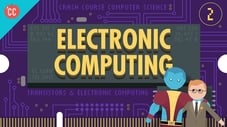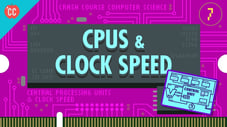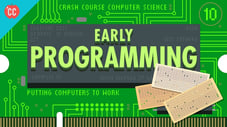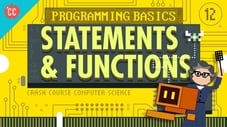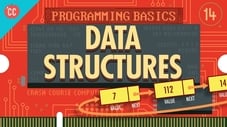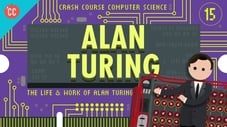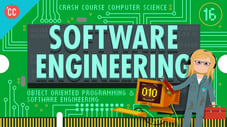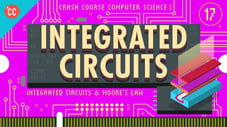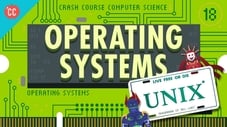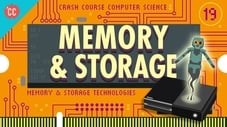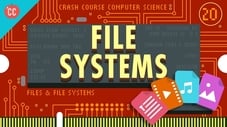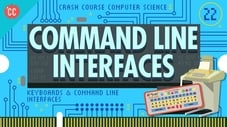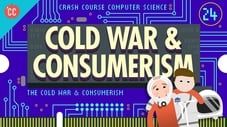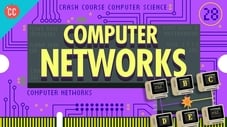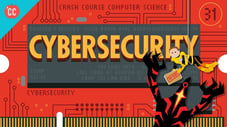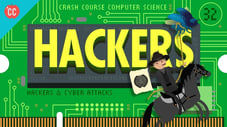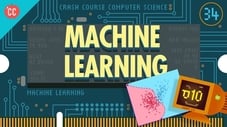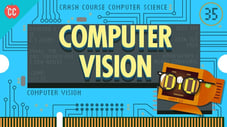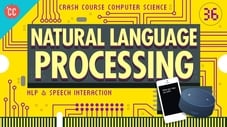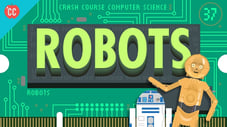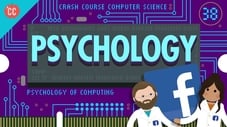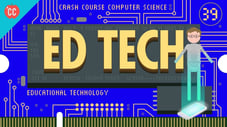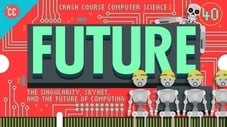
第 1 季 (2017)
← Zurück zur Staffelliste
Episoden 40
计算机早期历史
欢迎参加计算机科学速成班!今天,我们要看一看计算的起源,因为尽管我们的计算机相对较新,但对计算的需求却不是。
Weiterlesen电子计算机
上一集我们讲到在20世纪初,使用了特殊用途的计算设备,比如赫尔曼·霍勒瑞斯的“表格机”。但随着人类文明规模的不断扩大,对更先进、更强大设备的需求也在不断增长。很快,这些柜子大小的机电计算机将成长为房间大小的庞然大物。虽然有时候会出错,但是这些大型计算机将有助于开创一个新的计算时代——电子计算。
Weiterlesen布尔逻辑和逻辑门
今天,Carrie Anne要看一看我们上一集讲的晶体管是如何被用来执行复杂的动作的。只有开和关两种状态,电流就可以用来执行许多逻辑运算,这些运算是由一个叫做布尔代数的数学分支来指导的。我们将集中讨论三个基本的运算—NOT,AND,AND OR—并展示它们是如何在一系列非常有用的电路中产生的。正是这些简单的电路为我们更复杂的机器打下了基础。
Weiterlesen二进制
今天,我们来看看计算机是如何使用1和0来表示我们所有的数据流的——从短信、照片到音乐和网页。我们将重点讨论如何使用这些二进制值来表示数字和字母,并讨论我们对更大更复杂的值执行操作的需求如何将我们从8位视频游戏带到漂亮的Instagram照片,从电子邮件中无法读取的乱码文本带到通用语言编码方案。
Weiterlesen算术逻辑单元:ALU
今天我们将讨论所有现代计算机的基本部分。基本上所有其他东西都使用的东西——算术和逻辑单元(ALU)。ALU可能不必最令人兴奋的名字,但它是计算机的数学大脑,负责计算机所做的所有计算!其实也没那么复杂。所以今天我们将使用前几集中学习到的二进制和逻辑门从头开始构建一个,然后在第7集中构建计算机的核心CPU时,我们将使用我们在这里制作的ALU。
Weiterlesen寄存器和内存
今天我们要创造记忆!使用我们在第三集中讨论的基本逻辑门,我们可以构建一个存储单个bit的电路,然后通过一些巧妙的缩放(当然还有许多新的抽象级别),我们将向您展示如何构建在我们今天的计算机中随处可见的随机存取存储器(RAM)。RAM是计算机的工作存储器。它保存着计算机正在执行的信息,因此是计算机运行的关键部件。下周我们将使用这个RAM和上一集制作的ALU来帮助我们构建CPU——计算机的心脏。
Weiterlesen中央处理器(CPU)
今天我们要建造每一台计算机的心脏—中央处理器。CPU的工作是执行我们熟悉和喜爱的程序,比如你知道的像GTAV,Slack等等,为了制作我们的CPU,我们将引入前两集制作的ALU和RAM,然后逐步完成一些时钟周期。警告:这可能是本系列中最复杂的一集,我们自己看了几遍,不要担心.03Hz,我们认为你(的运算速度)可以跟得上。
Weiterlesen指令和程序
今天我们要从硬件向软件迈出第一步!使用上一集我们构建的CPU,我们将运行一些指令,并引导您了解程序如何在机器级别运行。
我们将向您展示如何使用不同的程序来执行不同的任务,以及软件如何解锁硬件中未内置的新功能。这一集和上一集一样非常复杂,但别担心——随着我们进入编程阶段,这个机器级别的操作码、地址和寄存器的概念将像本系列中的许多概念一样被抽象出来。
Weiterlesen高级CPU设计
现在,我们已经构建并编程了自己的CPU,我们将后退一步,看看CPU速度是如何从每秒几个周期快速提高到千兆赫兹的!当然,其中一些改进来自更快、更高效的晶体管,但为了提高性能,已经实施了一些硬件设计。你可能听过或读过很多这样的东西——它们是几乎每一个新的CPU版本都附带的流行语——比如指令流水线、缓存、触发器、超标量、分支预测、多核处理器,甚至超级计算机!这些设计相当复杂,但背后的基本概念并不复杂。
Weiterlesen早期的编程方式
自1801年约瑟夫·玛丽·贾卡发明纺织织机以来,就一直需要向我们的机器发出指示。在最后几集中,我们的指令已经在我们的计算机内存中了,但我们需要谈谈它们是如何到达那里的——这是编程的核心。
今天,我们将回顾编程的历史,以及将我们从穿孔卡片和穿孔纸带到交换机的插板和控制台的创新。这些技术将把我们带到20世纪70年代中期和家庭计算的开始,但它们有局限性,真正需要的是一种更简单、更易访问的程序编写方法——编程语言。我们下个星期就讲到了。
Weiterlesen编程语言发展史
因此,我们结束了上一集的硬件编程与东西,如插件板和巨大的开关面板,但真正需要的是一个更通用的方式来编程的计算机-软件!在本系列的大部分时间里,我们一直在讨论机器代码,或者我们的计算机为执行操作而读取的1和0,但是在1和0中给我们的计算机指令是非常低效的,需要一种“更高级”的语言。这导致了汇编代码和汇编程序的发展,使我们能够使用操作数和助记符更容易地编写程序,但汇编语言仍然与底层硬件相联系。因此,到1952年,海军军官格雷斯·霍珀(Grace Hopper)帮助创建了第一种高级编程语言A-0和编译器,将这些代码翻译到我们的机器上。这将最终导致IBM的Fortran,并在未来几十年内迎来计算语言的黄金时代。最重要的是,这些新语言利用新的抽象使编程变得更容易和更强大,使越来越多的人有能力创造新的和惊人的东西。
Weiterlesen编程原理-语句和函数
我们将从为自己的视频游戏创建小程序开始,展示语句和函数是如何工作的。我们不会用特定语言编写代码,但是我们将向您展示条件语句,例如IF和ELSE语句,而循环和FOR循环如何控制几乎所有语言中的程序流,然后我们将这些指令打包成我们的游戏调用的函数,以执行越来越复杂的操作。
Weiterlesen算法入门
算法是完成计算所必需的一系列步骤——它们是我们的设备实际工作的核心。这不是一个新概念。由于数学本身的发展,算法已经被用来帮助我们更有效地完成任务,但今天我们要看一些现代计算问题,如排序和图形搜索,并显示我们如何使他们更有效,使您可以更容易地找到便宜的机票或地图方向的临冬城。。。或者像餐馆什么的。
Weiterlesen数据结构
Today we’re going to talk about on how we organize the data we use on our devices. You might remember last episode we walked through some sorting algorithms, but skipped over how the information actually got there in the first place! And it is this ability to store and access information in a structured and meaningful way that is crucial to programming. From strings, pointers, and nodes, to heaps, trees, and stacks get ready for an ARRAY of new terminology and concepts.
Weiterlesen阿兰·图灵
Today we’re going to take a step back from programming and discuss the person who formulated many of the theoretical concepts that underlie modern computation - the father of computer science himself: Alan Turing. Now normally we try to avoid “Great Man" history in Crash Course because truthfully all milestones in humanity are much more complex than just an individual or through a single lens - but for Turing we are going to make an exception. From his theoretical Turing Machine and work on the Bombe to break Nazi Enigma codes during World War II, to his contributions in the field of Artificial Intelligence (before it was even called that), Alan Turing helped inspire the first generation of computer scientists - despite a life tragically cut short.
Weiterlesen软件工程
Today, we’re going to talk about how HUGE programs with millions of lines of code like Microsoft Office are built. Programs like these are way too complicated for a single person, but instead require teams of programmers using the tools and best practices that form the discipline of Software Engineering. We'll talk about how large programs are typically broken up into into function units that are nested into objects known as Object Oriented Programming, as well as how programmers write and debug their code efficiently, document and share their code with others, and also how code repositories are used to allow programmers to make changes while mitigating risk.
Weiterlesen集成电路&摩尔定律
So you may have heard of Moore's Law and while it isn't truly a law it has pretty closely estimated a trend we've seen in the advancement of computing technologies. Moore's Law states that we'll see approximately a 2x increase in transistors in the same space every two years, and while this may not be true for much longer, it has dictated the advancements we've seen since the introduction of transistors in the mid 1950s. So today we're going to talk about those improvements in hardware that made this possible - starting with the third generation of computing and integrated circuits (or ICs) and printed circuit boards (or PCBs). But as these technologies advanced a newer manufacturing process would bring us to the nanoscale manufacturing we have today - photolithography.
Weiterlesen操作系统
So as you may have noticed from last episode, computers keep getting faster and faster, and by the start of the 1950s they had gotten so fast that it often took longer to manually load programs via punch cards than to actually run them! The solution was the operating system (or OS), which is just a program with special privileges that allows it to run and manage other programs. So today, we’re going to trace the development of operating systems from the Multics and Atlas Supervisor to Unix and MS-DOS, and take at look at how these systems heavily influenced popular OSes like Linux, Windows, MacOS, and Android that we use today.
Weiterlesen内存&储存介质
So we’ve talked about computer memory a couple times in this series, but what we haven’t talked about is storage. Data written to storage, like your hard drive, is a little different, because it will still be there even if the power goes out - this is known as non-volatile memory. Today we’re going to trace the history of these storage technologies from punch cards, delay line memory, core memory, magnetic tape, and magnetic drums, to floppy disks, hard disk drives, cds, and solid state drives. Initially, volatile memory, like RAM was much faster than these non-volatile storage memories, but that distinction is becoming less and less true today.
Weiterlesen文件系统
Today we’re going to look at how our computers read and interpret computer files. We’ll talk about how some popular file formats like txt, wave, and bitmap are encoded and decoded giving us pretty pictures and lifelike recordings from just strings of 1’s and 0’s, and we’ll discuss how our computers are able to keep all this data organized and readily accessible to users. You’ll notice in this episode that we’re starting to talk more about computer users, not programmers, foreshadowing where the series will be going in a few episodes.
Weiterlesen压缩
So last episode we talked about some basic file formats, but what we didn’t talk about is compression. Often files are way too large to be easily stored on hard drives or transferred over the Internet - the solution, unsurprisingly, is to make them smaller. Today, we’re going to talk about lossless compression, which will give you the exact same thing when reassembled, as well as lossy compression, which uses the limitations of human perception to remove less important data. From listening to music and sharing photos, to talking on the phone and even streaming this video right now the ways we use the Internet and our computing devices just wouldn’t be possible without the help of compression.
Weiterlesen命令行界面
Today, we are going to start our discussion on user experience. We've talked a lot in this series about how computers move data around within the computer, but not so much about our role in the process. So today, we're going to look at our earliest form of interaction through keyboards. We'll talk about how the keyboard got its qwerty layout, and then we'll track its evolution in electronic typewriters, and eventually terminals with screens. We are going to focus specifically on text interaction through command line interfaces, and next week we'll take a look at graphics.
Weiterlesen屏幕&2D图形显示
Today we begin our discussion of computer graphics. So we ended last episode with the proliferation of command line (or text) interfaces, which sometimes used screens, but typically electronic typewriters or teletypes onto paper. But by the early 1960s a number of technologies were introduced to make screens much more useful from cathode ray tubes and graphics cards to ASCII art and light pens. This era would mark a turning point in computing - computers were no longer just number crunching machines, but potential assistants interactively augmenting human tasks. This was the dawn of graphical user interfaces which we’ll cover more in a few episodes.
Weiterlesen冷战和消费主义
Today we’re going to step back from hardware and software, and take a closer look at how the backdrop of the cold war and space race and the rise of consumerism and globalization brought us from huge, expensive codebreaking machines in the 1940s to affordable handhelds and personal computers in the 1970s. This is an era that saw huge government funded projects - like the race to the moon. And afterward, a shift towards the individual consumer, commoditization of components, and the rise of the Japanese electronics industry.
Weiterlesen个人计算机革命
Today we're going to talk about the birth of personal computing. Up until the early 1970s components were just too expensive, or underpowered, for making a useful computer for an individual, but this would begin to change with the introduction of the Altair 8800 in 1975. In the years that follow, we'll see the founding of Microsoft and Apple and the creation of the 1977 Trinity: The Apple II, Tandy TRS-80, and Commodore PET 2001. These new consumer oriented computers would become a huge hit, but arguably the biggest success of the era came with the release of the IBM PC in 1981. IBM completely changed the industry as its "IBM compatible" open architecture consolidated most of the industry except for, notably, Apple. Apple chose a closed architecture forming the basis of the Mac Vs PC debate that rages today. But in 1984, when Apple was losing marketshare fast it looked for a way to offer a new user experience like none other - which we'll discuss next week.
Weiterlesen图形用户界面
Today, we're going to discuss the critical role graphical user interfaces, or GUIs played in the adoption of computers. Before the mid 1980's the most common way people could interact with their devices was through command line interfaces, which though efficient, aren't really designed for casual users. This all changed with the introduction of the Macintosh by Apple in 1984. It was the first mainstream computer to use a GUI, standing on the shoulder of nearly two decades of innovation including work from the father of the GUI himself, Douglas Englebart, and some amazing breakthroughs at Xerox Parc.
Weiterlesen3D 图形
Today we’re going to discuss how 3D graphics are created and then rendered for a 2D screen. From polygon count and meshes, to lighting and texturing, there are a lot of considerations in building the 3D objects we see in our movies and video games, but then displaying these 3D objects of a 2D surface adds an additional number of challenges. So we’ll talk about some of the reasons you see occasional glitches in your video games as well as the reason a dedicated graphics processing unit, or GPU, was needed to meet the increasing demand for more and more complex graphics.
Weiterlesen计算机网络
Today we start a three episode arc on the rise of a global telecommunications network that changed the world forever. We’re going to begin with computer networks, and how they grew from small groups of connected computers on LAN networks to eventually larger worldwide networks like the ARPANET and even the Internet we know today. We'll also discuss how many technologies like Ethernet, MAC addresses, IP Addresses, packet switching, network switches, and TCP/IP were implemented to new problems as our computers became ever-increasingly connected. Next week we’ll talk about the Internet, and the week after the World Wide Web!
Weiterlesen互联网
Today, we're going to talk about how the Internet works. Specifically, how that stream of characters you punch into your browser's address bar, like "youtube.com", return this very website. Just to clarify we're talking in a broader sense about that massive network of networks connecting millions of computers together, not just the World Wide Web, which is a portion of the Internet, and our topic for next week. Today, we're going to focus on how data is passed back and forth - how a domain name is registered by the Domain Name System, and of course how the data requested or sent gets to the right person in little packets following standard Internet Protocol, or IP. We'll also discuss two different approaches to transferring this data: Transmission Control Protocol, or TCP, when we need to be certain no information is lost, and User Datagram Protocol, or UDP, for those time sensitive applications - because nobody wants an email with missing text, but they also don't want to get lag-fragged in their favorite first person shooter.
Weiterlesen万维网
Today we’re going to discuss the World Wide Web - not to be confused with the Internet, which is the underlying plumbing for the web as well as other networks. The World Wide Web is built on the foundation of simply linking pages to other pages with hyperlinks, but it is this massive interconnectedness that makes it so powerful. But before the web could become a thing, Tim Berners-Lee would need to invent the web browser at CERN, and search engines would need to be created to navigate these massive directories of information. By the mid 1990’s we will see the rise of Yahoo and Google and monolithic websites like Ebay and Amazon, forming the web we know today. But before we end our unit on the Internet we want to take a moment to discuss the implications of Net Neutrality, and its potential to shape the Internet's future.
Weiterlesen计算机安全
Cybersecurity is a set of techniques to protect the secrecy, integrity, and availability of computer systems and data against threats. In today’s episode, we’re going to unpack these three goals and talk through some strategies we use like passwords, biometrics, and access privileges to keep our information as secure, but also as accessible as possible. From massive Denial of Service, or DDos attacks, to malware and brute force password cracking there are a lot of ways for hackers to gain access to your data, so we’ll also discuss some strategies like creating strong passwords, and using 2-factor authentication, to keep your information safe.
Weiterlesen黑客&攻击
Today we're going to talk about hackers and their strategies for breaking into computer systems. Now, not all hackers are are malicious cybercriminals intent on stealing your data (these people are known as Black Hats). There are also White Hats who hunt for bugs, close security holes, and perform security evaluations for companies. And there are a lot of different motivations for hackers—sometimes just amusement or curiosity, sometimes for money, and sometimes to promote social or political goals. Regardless, we're not going to teach you how to become a hacker in this episode but we are going to walk you through some of the strategies hackers use to gain access to your devices, so you can be better prepared to keep your data safe.
Weiterlesen加密
Today we’re going to talk about how to keep information secret, and this isn’t a new goal. From as early as Julius Caesar’s Caesar cipher to Mary, Queen of Scots, encrypted messages to kill Queen Elizabeth in 1587, theres has long been a need to encrypt and decrypt private correspondence. This proved especially critical during World War II as Allan Turing and his team at Bletchley Park attempted to decrypt messages from Nazi Enigma machines, and this need has only grown as more and more information sensitive tasks are completed on our computers. So today, we’re going to walk you through some common encryption techniques such as the Advanced Encryption Standard (AES), Diffie-Hellman Key Exchange, and RSA which are employed to keep your information safe, private, and secure.
Weiterlesen机器学习&人工智能
So we've talked a lot in this series about how computers fetch and display data, but how do they make decisions on this data? From spam filters and self-driving cars, to cutting edge medical diagnosis and real-time language translation, there has been an increasing need for our computers to learn from data and apply that knowledge to make predictions and decisions. This is the heart of machine learning which sits inside the more ambitious goal of artificial intelligence. We may be a long way from self-aware computers that think just like us, but with advancements in deep learning and artificial neural networks our computers are becoming more powerful than ever.
Weiterlesen计算机视觉
Today we’re going to talk about how computers see. We’ve long known that our digital cameras and smartphones can take incredibly detailed images, but taking pictures is not quite the same thing. For the past half-century, computer scientists have been working to help our computing devices understand the imagery they capture, leading to advancements everywhere, from tracking hands and whole bodies, biometrics to unlock our phones, and eventually giving autonomous cars the ability to understand their surroundings.
Weiterlesen自然语言处理
Today we’re going to talk about how computers understand speech and speak themselves. As computers play an increasing role in our daily lives there has been an growing demand for voice user interfaces, but speech is also terribly complicated. Vocabularies are diverse, sentence structures can often dictate the meaning of certain words, and computers also have to deal with accents, mispronunciations, and many common linguistic faux pas. The field of Natural Language Processing, or NLP, attempts to solve these problems, with a number of techniques we’ll discuss today. And even though our virtual assistants like Siri, Alexa, Google Home, Bixby, and Cortana have come a long way from the first speech processing and synthesis models, there is still much room for improvement.
Weiterlesen机器人
Today we're going to talk about robots! Robots are often thought as a technology of the future, but they're already here by the millions in the workplace, our homes, and pretty soon on the roads. We'll discuss the origins of robotics to its proliferation, and even look at some common control designs that were implemented to make them more useful in the workplace. Robots are often thought of as a menace or danger to society, and although there definitely is the propensity for malicious uses, robots also have the potential to drastically improve the world.
Weiterlesen计算机心理学
We’ve spent most of this series talking about computers. Which makes sense - this is Crash Course COMPUTER SCIENCE after all. But at their core computers are tools employed by humans and humans are pretty complicated. So today, we’re going to discuss some psychological considerations in building computers like how to make them easier for humans to use, the uncanny valley problem when humanoid robots gets more and more humanlike, and strategies to make our devices work better with us by incorporating our emotions and even altering our gaze. Oh, and we'll talk about Carrie Anne's all time favorite user interface design principle - knurling.
Weiterlesen教育科技
Today we’re going to go a little meta and talk about how computer science can support learning with educational technology. We here at Crash Course are big fans of interactive in-class learning and hands-on experiences, but we also believe in the additive power of educational technology inside and outside the classroom from the Internet itself and Massive Open Online Courses, or MOOCs to AI driven intelligent tutoring systems and virtual reality.
Weiterlesen奇点,天网,计算机的未来
In our SERIES FINALE of Crash Course Computer Science we take a look towards the future! In the past 70 years electronic computing has fundamentally changed how we live our lives, and we believe it’s just getting started. From ubiquitous computing, artificial intelligence, and self-driving cars to brain computer interfaces, wearable computers, and maybe even the singularity there is so much amazing potential on the horizon. Of course there is also room for peril with the rise of artificial intelligence and more immediate displacement of much of the workforce through automation. It’s tough to predict how it will all shake out, but it’s our hope that this series has inspired you to take part in shaping that future. Thank you so much for watching.
Weiterlesen
